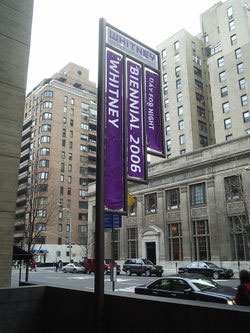
Whitney Biennial, 2006
Day For Night
(or Ephemera)
By Douglas Singleton
No Sex. No War. No Me.
First thoughts on the 2006 Whitney Biennial, titled Day For Night? Be careful what you wish for, you just might get it. I say
this because this Biennial is, in essence, the type of high profile group showing I’ve longed for, full of trends that intone
the underbelly of the New York and international art worlds—much oblique installation work, obscure, unassuming sculpture &
pseudo-painting, the ever expanding intricate (tiny) drawing craze (Jennie Smith’s charcoal and watercolor drawings of
fantastical animals a good example), conceptually layered persona-calligraphic work, be they objects, omni-installation, or
video, loads of video. Fuck painting! (I’m joking, don’t really fuck painting). This is what I’ve spied in the streets and
revered in large part over the last five years or so, and subsequently yearned to see in these types of shows, if not in
Chelsea itself. And here it all is, in a Biennial nonetheless. And how do I feel? Underwhelmed, embarrassingly so. Be careful
what you wish for—you just might get it. Even some artists whose work I’ve admired, Anthony Burdin and his scathing music
collage and living-out-of-a-car installation work which I’ve really liked at Maccarone in Chinatown on a number of occasions—but
here his solo room drew a “whatever” from me. Hanna Linden’s photographs of masked, naked women standing in forests on rocks and
streams seemed sinister at Rivington Arms when initially viewed. But here? Well, not a whole lot. Context can be a killer. The work in this Biennial
as a whole is as if an assemblage of ephemera.
 Don’t get me wrong—there is much interesting work to admire. Urs Fischer’s blown holes in the gallery walls that one walks
through to get to his work are fantastic. Inside the room branches are suspended from the ceiling on chains with candles perched
upon them circling the room, dripping wax onto the floor. Religious circles are fashioned, mysterious and solemn. Troy Brauntuch
displays gorgeous conté crayon drawings on black cotton canvases of folded shirts stacked in a closet, quiet and contemplative,
reminiscent of Richter or fellow “Pictures Generation” artists like Richard Prince. Brauntuch’s work makes the simple and mundane
appear epic, and on deeper reflection even frightening. The Otabenga Jones & Associates crew from Houston, concerned with
African American identity politics, tear shit up with a collective brick wall with slit peep holes in it through which one
looks into an “African garden.” The individual Otabenga artists share a room—Robert A. Pruitt, whose work I saw in
“Splat Boom Pow!” at ICA in Boston a couple of years back, here has drawings and sculptures comprised of a KKK robe that
looks like a high school sports uniform, and a voodoo communion table full of idols. Jamal Cyrus has more of those ink drawings I’m so hot for and collage work filled with black iconography. Dawolu Jabari Anderson displays large-scale drawings of Afro-American-isms on aged paper, part of a “Frederick Douglass Self-Defense Manual”. The real “Ota Benga” was a Pygmy brought from the Belgium Congo to the U.S. in 1904 and later put on exhibition with animals at the Bronx Zoo. Paul Chan had a wonderful piece in Greater New York 2005, and here shows “1st
Don’t get me wrong—there is much interesting work to admire. Urs Fischer’s blown holes in the gallery walls that one walks
through to get to his work are fantastic. Inside the room branches are suspended from the ceiling on chains with candles perched
upon them circling the room, dripping wax onto the floor. Religious circles are fashioned, mysterious and solemn. Troy Brauntuch
displays gorgeous conté crayon drawings on black cotton canvases of folded shirts stacked in a closet, quiet and contemplative,
reminiscent of Richter or fellow “Pictures Generation” artists like Richard Prince. Brauntuch’s work makes the simple and mundane
appear epic, and on deeper reflection even frightening. The Otabenga Jones & Associates crew from Houston, concerned with
African American identity politics, tear shit up with a collective brick wall with slit peep holes in it through which one
looks into an “African garden.” The individual Otabenga artists share a room—Robert A. Pruitt, whose work I saw in
“Splat Boom Pow!” at ICA in Boston a couple of years back, here has drawings and sculptures comprised of a KKK robe that
looks like a high school sports uniform, and a voodoo communion table full of idols. Jamal Cyrus has more of those ink drawings I’m so hot for and collage work filled with black iconography. Dawolu Jabari Anderson displays large-scale drawings of Afro-American-isms on aged paper, part of a “Frederick Douglass Self-Defense Manual”. The real “Ota Benga” was a Pygmy brought from the Belgium Congo to the U.S. in 1904 and later put on exhibition with animals at the Bronx Zoo. Paul Chan had a wonderful piece in Greater New York 2005, and here shows “1st Light,” an exquisite room with light and shadows projected onto the floor, visions of random floating objects and birds in silhouette, and is beautiful. I’m a sucker for this kind of visually elegiac work.
But on a whole I did not find myself moved by this Biennial, the synapses linking the works never connected for me, little energy flowed across them, and that surprised me because this was my type of show. I’m one of those dupes who never really dislike Biennial’s—even if they’re “bad” there’s always something ridiculous or outlandish or subversive or new or absurd that gets my blood pumping. But there was no surprise here; I was never shocked. Boring? This is what I felt.
Day For Night
This is the first Biennial to have a title—Day For Night, and I keep forcing myself to come back to the phrase to better understand the work on view. Of course it’s pretty simple—Truffaut’s film was named after the term for filmmakers using filters to artificially manufacture twilight darkness while shooting during the day. Pierre Huyghe’s centerpiece film, “A Journey That Wasn’t,” illustrates the concept easily enough—an artic exploratory expedition symbolically transported to Central Park for an eerie recreation with orchestra, fake icebergs, penguins (what is it with these French directors and penguins?), and an audience somehow “re-living” the experience in New York City—a created netherworld. Manufactured realities, recreated. Day for night, pretty simple. But how does that translate to the rest of the work on display in the Biennial? It is here that I became curious with the intentions and thought processes of curators Chrissie Iles and Philippe Vergne, and wonder what I might have missed.
Whatever the intentions, one wonders what the lay masses milling through the Whitney make of all of this: Sturtevant’s room of recreated Duchamp pieces, bewilderingly plain without context, and probably still so even with context. Reena Spaulings, the imaginary artist pranksters sprang from a fictional gallery (now real?) slide in incongruous metal convenience store awnings on the floor and over an elevator with “Emily Fisher Lan” stenciled on it, titled after a Whitney benefactor who the particular gallery is named after and whose name on the wall the awning partially obscures. You’d need a MFA to get it, but if you do it’s pretty hype and moving. Gedi Sibony’s sparse, enigmatic sculptural environments of ostensibly accidentally arranged plywood and carpet sections (with that Beuys felt smell) are anti-installation spaces really, quiet and fragmented. Sibony’s work, which also moved me, appears thrown-off detritus, keeping in line with his allusive, austere creative agenda. Not exactly Renaissance or MOMA ground. Whatever one may or may not gleam about this Biennial, I fault the curators for a show that in large part fails to speak a language the masses searching for an understanding of contemporary art might possibly understand. There, I said it. Obscure, insular, diffuse. Granted, previous Biennials often presented over-sexy, flashy, “big” work only peripherally associated with any thematic import, “wow” art people were bound to respond to. Ok, but pure, maddening obscurity instead? The Gore Vidal piece by Francesco Vezzoli (which also showed at the Venice Biennale) is beside the point—you’d make a richer statement if you exhibited the actual trailer from the original Caligula itself, in my humble opinion. (Though I did watch the damn thing twice, ogling for real sex.)
Let’s approach it from another direction—the Biennial’s one-room side exhibition within the exhibition, “Down By Law,” curated by Chelsea’s contrarian doorway space, the Wrong Gallery, in the Whitney’s mezzanine Gilman Gallery, centers around imagery that concerns itself with the myth of the “American Outlaw,” and was instantly more palpable to my artistic sensibilities and antennae, moments after I’d walked into the room. The Dread Scott work, macabre Weegee photographs, Monica Bonvicini’s “Eternmale” (boy stuff all over this room), Paul Cadmus’ 1935 “To The Lynching!”, work from David Wojnarowicz’ “Arthur Rimbaud in NY” series, a wonderful Marcel Dzama ink & watercolor, untitled works from the Fulton County prison farm, Paul Chan (also in the main Biennial) with “Democracy will remain one of the most difficult issues preoccupying human thought, political thought and constitutional formula, in Iraq and elsewhere, because democracy is a human as well as a major political issue”, “Piss Christ,” Vik Muniz’ “Memory Rendering of Kent State Shootings,” Warhol’s “Electric Chair,” Kara Walker, and Mapplethorpe. Outlaw angel art that in totality make glorious sense together. A colleague of mine stated this was simply because the curation of “Down By Law” is far superior to that Iles and Vergne display in the Biennial itself. And though I was inclined to agree, somehow I wonder if my reaction had more to do with “Down By Law” using a curatorial language more easily recognizable, its process “synapses” something I’ve recognized over the years, and therefore more readily warmed to. Perhaps the language the actual Biennial uses is not so easily graspable, offering no easy “comfort,” and therefore failing to speak to me. Iles and Vergne attempt to force us to approach art that admittedly some of us feel we know very well in a “new” and contrary-critical manner. Otherwise it would just be business as usual and simply looking over and through work without truly seeing it in any meaningful context. Or this is a thought.
The curators profess in one of their statements that the “curatorial lens of this Biennial aims to capture the artifice of American culture…Duchamp’s geographical fluidity was matched by an osmosis between one identity or alter ego and another, creating an obfuscation that finds a strong echo in the spirit of this exhibition. The swing of the barometer…toward obfuscation, darkness, secrecy, and the irrational is, as always, determined by the artist[s].” “The artists…. are working in a space between pre- and post-modernist parameters—somewhere between day and night, between the history of forms and the forms of history. In this twilight zone, many things are called into question or obscured.”
Listen: War = Peace, 2 + 2 = 5, Darkness is Light.
I liked Todd Norsten’s oil paintings—a black, twisted pseudo-Mickey Mouse and another with the painted words, “Son, Jesus Loves You Still,” Anne Collier’s photographs of plain objects, Jay Heikes’ personal chopped-up tempera & graphite on photocopy recollection of a joke, “So There’s This Pirate….” and Monica Majoli’s haunting, fetishistic watercolors from her “Rubberman” series. Portraits of the 9/11 hijackers are surreptitiously dispersed throughout the museum (“day for night”). In addition there is much unnamed or “hidden” work strewn about: a painting by a “Miles Davis,” various scrawled wooden signs in stairways and leaning against walls—“Shit,” “Rama Lama Ding Dong,” and my favorite, “No Sex. No War. No Me.” A costumed gentleman (who I later found out was experimental musician/artist Momus) walked through the galleries on the day I was there speaking through a bullhorn. His near whispered invocations about the art were silly, and people simply ignored him or seemed not notice at all—filing it under the usual performance art shenanigans. (I ran from him—felt he was following me around.) But my lady said he had very interesting things to say about not paying too much attention to the works of art themselves, but the ideas linking them. This is by no means a direct quote.
Shit, Ephemera
Hidden art, clandestinely planted art, sincere—ergo obvious—“peace towers” and political art, website clones, blurred lines between individual works of art and artistic mediums, as sometimes “paintings can be part of a larger installation environment” as Iles and Vergne’s press materials state, hung haphazardly, almost seemingly welcoming vitriol—(day for night). Although underwhelming this is a sneaky Biennial. Yes, I would be lying if I didn’t say that, all said and done, I much preferred the current Deitch Projects Garden Party show and its cute & freaky Deflowered weird-o-rama Vernal Equinox performance cooked up by Julie Atlas Muz, or that I found much more engaging and breathtaking the spliced multidisciplinary work of Cynthia Hopkins, Jonah Bokaer, and all of the dancer/performers in PS 122’s recent Danceoff!, hardly about “dance” really, or Drawn Together for that matter.
Yet, despite my initial disappointment, the more I think about this Biennial the more I trust it. Though I am wary of what I wished for, more so I like it. Sometimes the best judge of a work of art is its ability to stick with you, or engender violent argument, or dismissal (or indeed vitriol). To not comfort. This day for night accomplishes that.
|











































